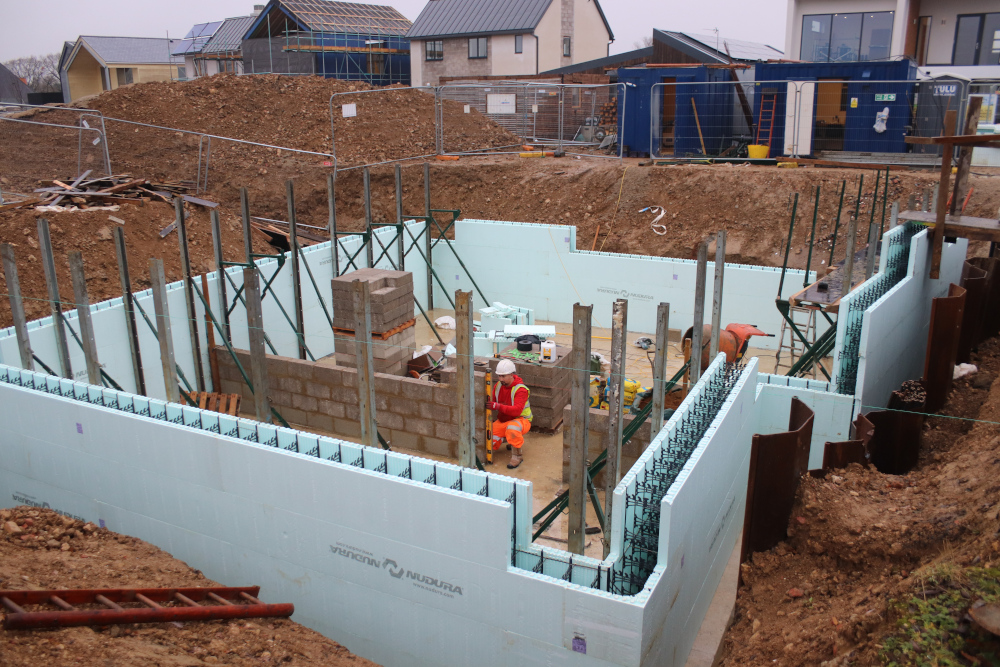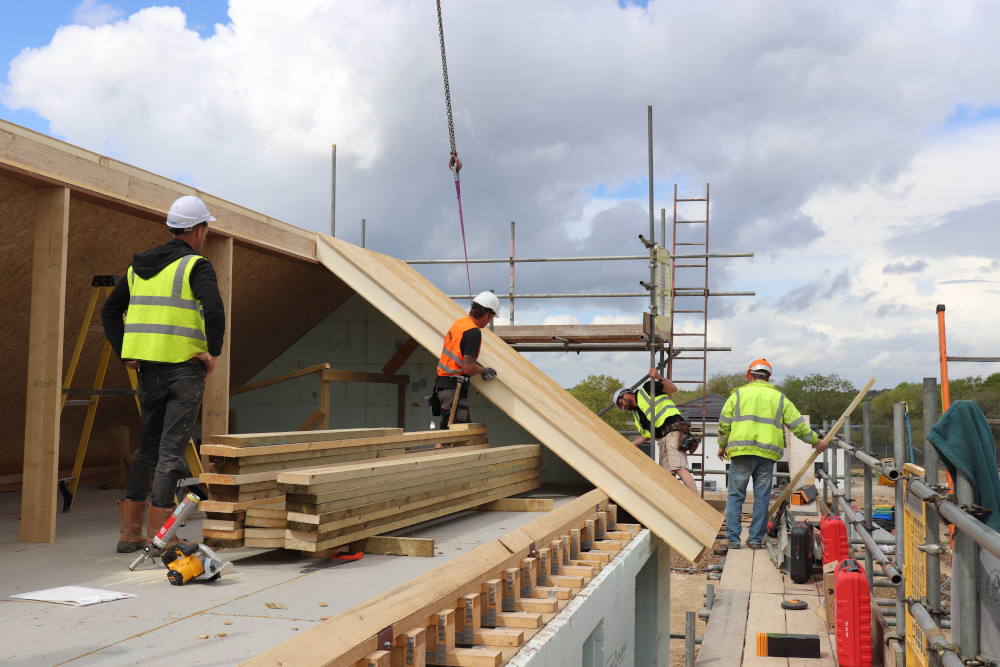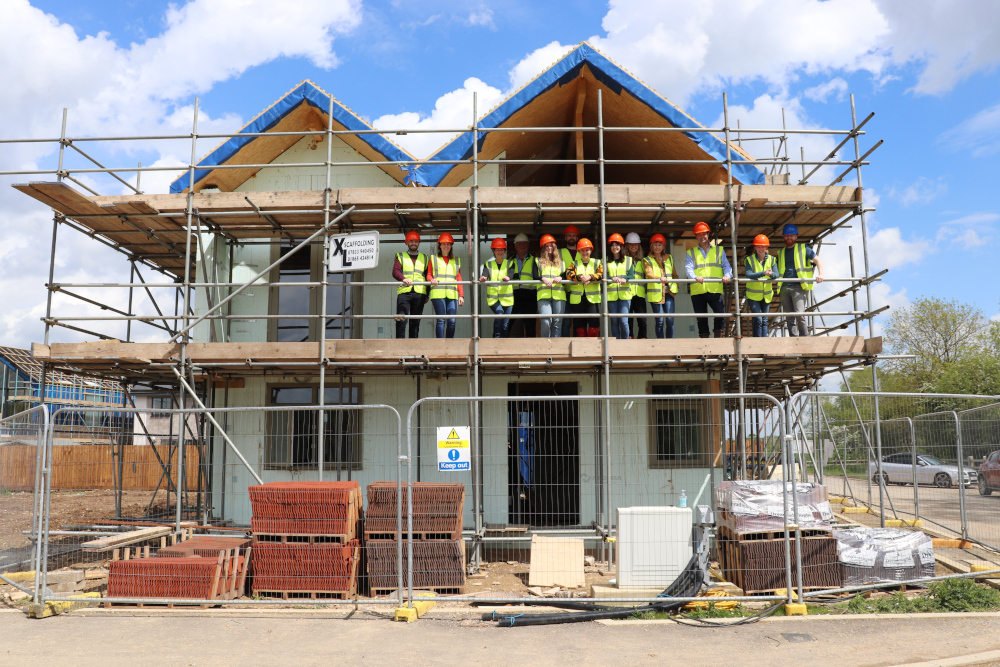On Saturday 29 February the team at Graven Hill is inviting would-be homeowners to take a peek inside its latest show house by HexxHome on the Bicester site.
Designed by Charlie Luxton in partnership with NaCSBA member HexxHome, the three-bedroom property comes with a balcony, as well as a host of eco features including solar panels, battery storage, underfloor heating and a mechanical ventilation heat recovery (MVHR) system for heating and cooling with maximum efficiency.
Visitors to the site on Saturday can enjoy a tour of the HexxHome, and the opportunity to find out more about building at Graven Hill, including the range of different routes to home ownership available on the site. This includes the chance to discover the brand new release of custom build new homes – a range of three, four and five-bedroom homes that are available to reserve off-plan (From left to right below, the Dee, Tyne and Dart). The homes come with a completely bespoke choice of layout, fixture and finish options, giving you the chance to have a tailored home that’s fully commissioned by you, with someone else doing all the hard work.
Graven Hill already has a selection of two and three-bed terraced homes for immediate purchase, which are ready to view, if your need to move is more pressing. The custom build and new homes on the site have been designed to meet a range of budgets and are available to purchase with as little as five percent deposit with Help to Buy.




Create your ideal home at Graven Hill
HexxHome boosts the offering for visitors to the site seeking information and inspiration for building, following the launch of the Build It Self Build Education House in October 2019, a new facility taking novice builders through the range of processes and decisions needed to be made on your journey.
Karen Curtin, managing director at Graven Hill, said:
“Saturday is set to be a real ‘access-all-areas’ event. Not only will we be unveiling our first off-site masonry show home, but visitors will also have the opportunity to preview and reserve their dream home from our updated range of custom build new properties.
“In our opinion, it’s time to take a new approach to the house buying process and put the power back into the hands of the purchaser. With speed, efficiency and cost-effectiveness on their side, prefabricated methods of construction have certainly earned their place alongside ‘traditional’ housebuilding methods. They provide an ideal solution for those who wish to create a bespoke, low-energy home, without the hassle of managing a construction process.”
Date: Saturday 29 February.
Where: Graven Hill Marketing Suite, 11 Foundation Square, Bicester, OX25 2AQ.
Water Lilies in Kingweston, Bristol, is a 33-home eco self build housing community enabled by NaCSBA members Bright Green Futures, with three phases offering different options of home, from self build to custom build.
With 70% of plots sold, Phase 2 offers a rare opportunity to design an eco-home bespoke to the buyer’s needs and tastes. This presents the chance to bring your ideas to life to create a home like nothing else on the market, with creative support from acclaimed Clifton Lido architects, Marshall and Kendon.
Suited for people at any stage of life, Water Lilies has attracted a diverse, multi-generational group of people to the award-winning eco development set on the edge of a conservation area. The site has direct walking and cycle routes into parkland near Blaise Castle and Kings Weston House and is a short trip away from the centre of Bristol.
Designed in harmony with the existing site, the scheme repurposes a reservoir as an underground car park to create a traffic-free shared garden, with a multi-purpose community building at the heart of the development.
Studies have shown that well designed neighbourhoods have a positive impact on wellbeing, and the availability of community facilities and access to green space are key contributing factors to people’s perceptions of where they live, a sentiment reflected in the government’s recently published Building Better, Building Beautiful report.
The development offers a flexible approach to modern living, with the shared garden ideal for children to play, while the multi-purpose community building can serve as a co-working hub for homeworkers. In fact, one of the benefits of the custom build route is that homeworkers can plan a dedicated office or studio space into their home, while older generations can accommodate potential future life changes with a flexible, accessible home design.
Constructed with sustainably sourced timber, the A-rated energy efficient homes include solar energy while giving y flexibility in the design and layout of internal spaces.
This means buyers can craft their home to complement their lifestyle and future-proof it to adapt to your household’s changing needs. One Water Lilies homebuyer highlighted this: “We got to imagine how we would live in it today, but also plan for the future with our family growing and having options to support our parents if needed.”


Address: The Old Reservoir, Kingsweston
Price: £475,050–£600,700
Bedrooms: 3–6 (flexibility with custom build)
Development: Water Lilies
Developer: Bright Green Futures
Contact: Bright Green Futures, 0117 955 6718, hello@brightgreenfutures.co.uk, www.brightgreenfutures.co.uk
Six custom Build plots in Lowfield Green, York, are all now reserved, with the new homes expected to be completed by November 2021.
Specialist custom build enabler Custom Build Homes has been working with City of York Council to enable the plots, supporting people interested in an owner-commissioned home with their applications, with the plots sold by bids following over 100 enquiries.
The south-facing plots at Lowfield Green are large enough to accommodate a large, three-to-five bedroom home, with the option to include a garage, with large gardens, with the purchaser’s ages spanning from 30-70, including first time buyers, reflecting the breadth of interest in a custom-built home.
The plots are part of a larger expansion to the city of York, which includes a range of new public amenities, green space and a mix of speculatively built new homes and a new co-housing scheme, brought on by design-led housing specialists Yorspace.
As an enabler, Custom Build Homes markets the plots, and is able to explain the process to potential buyers, including questions around design, delivery, finance, legal issues and planning. It also offered workshops to ensure the buyers fully understand the custom build process, including the parameters around what they can build with the planning permission for the site.
Anecdotal research by NaCSBA shows that educating consumers about the process of custom building, which often varies site-by-site, is a key element in ensuring that the process runs as smoothly as possible, and people know what to expect.
Tim Moon, City of York Council’s Community & Self Build Officer said, “Custom Build Homes has an unparalleled knowledge of the custom and self-build sector and has supported us to write our first ever design code, legal contracts, answering my constant barrage of questions and even standing out in the pouring rain showing prospective buyers our first ever serviced plots!”
Source: Custom Build Homes Image caption: Lowfield Green, York © 2020 Custom Build Homes
The National Custom and Self Build Association (NaCSBA) has released new findings showing that, while the number of self builders signing up to the Right to Build has grown, some local authorities are using “dirty tricks” to make it harder for people to sign up to the Custom and Self Build registers.
The research show that 1,400 new registrations signed the registers in the last year, bringing the total number of people who have signed up to Right to Build to 55,000. However, that total number on the registers is actually lower, due to people being removed for the wrong reasons.
NaCSBA estimates that over 13,000 people build an owner-commissioned home annually, a number which is growing slowly, but which it feels is far below actual demand. According to the Building Society Association over half of us (53%) would like to self build one day.
On Right to Build Day, NaCSBA conducted a Freedom of Interest request to all English councils about the registers to see how many plots had been permissioned, against the numbers that signed up in the first year of the registers (a part year running from April to October 2016).
The results showed patterns of behaviour that are very concerning, and which NaCSBA will be sharing with Government.
While local authorities are required to promote their registers, NaCSBA believes that both a lack of marketing and a range of “dirty tricks” by a growing minority of local authorities is making it much harder for individuals and groups to sign up to, and remain on, the custom and self build registers.
The research showed three significant areas of questionable activity by some local planning authorities, with more and more councils repeating these as a way to get around managing their duties.
This restricts the opportunity for people to self-build, acting as a restrictor in the market that limits activity to those with enough money or equity to commission their own home – the very people who didn’t need the support of the legislation in the first place.
Constraints: Local authorities are imposing unreasonable constraints to signing the registers. This includes the charging of excessive fees to sign up to, and stay on, the registers. It also could be a local connection test that denies those living outside an authority the chance to build a home there – despite no such restrictions being in place in the wider market.
Miscounting: Local authorities must demonstrate how many self build plots they have granted permission for, to compare to people on the registers each year. Many councils are counting plots intended for building on by housing developers as potential self-build plots – even though they have were never marketed as such.
Removals: Some councils have removed many people from their registers for the wrong reasons, thereby reducing the number of plots that they must permission. Examples include restarting registers with new conditions, removing people as part of GDPR data protection exercises and so on.
The 30 October 2019 was the first date ever when local authorities had to demonstrate that they had ‘permissioned’ enough plots to reflect the demand evidenced by the registers, for those that signed up in the first year of the registers. Permissioned means the act of granting a self or custom build permission, and each year councils will have to match ‘permissions’ with the number of people that signed up. It doesn’t mean that the council has to create plots itself, nor does it have to contact people on the registers.
Despite permissioning sufficient plots being a requirement of the law, 8% of all authorities said they had not met their duties under the legislation and 37% failed to provide any response at all.
Of all the councils, only 45% claimed that they had met their legal duties, but this figure includes those councils that achieved this by using some, or all, of the limiting factors set out above.
NaCSBA is calling on local authorities to act within the letter and the spirit of the law and do better in future, especially as it estimates that at least 8,000 people have been wrongfully removed from registers.
Andrew Baddeley-Chappell, NaCSBA’s CEO said, “For the first time, local authorities have had to meet a statutory duty to help self builders access the plots that are needed. It is clear that overall they have come up short. In some cases, this is despite the hard work and best efforts of the authority, and we recognise those that have worked hard in this area.
“In too many cases however local authorities have spent scarce time and effort not on delivering plots but rather on seeking to avoid their obligations. This cannot continue, not least if we are to deliver homes in the volume and of the quality that this country needs.”
England has the lowest known rate of owner-commissioned homes among developed economies, and NaCSBA plans to work with government to improve this, giving more people the chance to live in a home designed to suit their needs.
NaCSBA still urges anyone wanting to build, including community-led groups, to sign up to the Right to Build as the registers remain a vital element in demonstrating to authorities how many people want to self build.
Image: Marmalade Lane Cohousing by TOWN.
The best new homes of 2019 have been awarded in the Home of the Year awards by Homebuilding and Renovating and the Daily Telegraph, including Self Builds, extensions, conversions and renovations.
The awards have been running for nearly thirty years now, meaning that the judges have a good idea of what’s needed to elevate the entries into the winning criteria.
The overall winner of the Home of the Year & Best Contemporary Self Build went to Bunch Lane House, which had a build cost of £425,000 by Architect Vint & Smith Architecture + Design, pictured.
The judges felt that the house was a great design crafted for a great value of £1,500/m2, created by owner and architect Tavia and Richard Vint through the clever use of cost effective materials.

Best Contemporary-Style Self Build — sponsored by Folding Doors 2 U
Best Traditional-Style Self Build — sponsored by Rationel Windows & Doors
Best Extension — sponsored by ABC+ Warranty
Best Renovation — sponsored by Yeoman Rainguard
Best Conversion — sponsored by Etex (Exteriors) UK, providers of Eternit Slates
Best Eco Home — sponsored by Ecology Building Society
Home of the Year — sponsored by Icynene
Spirit of Self Build — sponsored by Hörmann
Readers’ Choice Award — sponsored by Selfbuild & Contract Floors
Check out all the winners on Homebuilding & Renovating’s website.
Credit: Homebuilding & Renovating/Simon Maxwell
What makes a good Christmas present? Socks that sit in a draw? A bottle of fizz that’s gone in an evening? Well why not make a year out of Christmas for the Self Builder in your life and give them a subscription to their favourite homes magazine for Self Builders.
NaCSBA knows that educating yourself is the surest way to get the most out of you build, and magazines are a great way to do this, from the latest products to avoiding pitfalls and saving money. The build titles are packed with seriously helpful features and case studies to show you what you could achieve – and usually how much a look actually costs – invaluable!

Don’t miss this exclusive offer brought to you buy Self Build Portal! Subscribe to Build It magazine for Christmas and receive 12 issues of for just £19.99. Don’t delay, this offer lasts until 21st December! Plus, you’ll get two free tickets to a Build It Live, worth £24! Build It’s Shows are Kent (8-9 Feb) North West (22-23 Feb) and South Central (6-7 June).
Regular Cover Price is £4.99.

Check out Self Build & Designs brilliant Christmas trial offer of 5 issues for £5, following on at £36 for the next twelve months by Direct Debit, especially for Self Build Portal users. Subscribers get a FREE pair of show tickets to either the Peterborough Show (7-8 March) or the Exeter show (12-13 September)
Regular Cover Price is £4.99.

Grab a subscription for Homebuilding & Renovating and start planning your own project, for £7.50 for three months or for £29,99 a year – all by Direct Debit, plus, plus claim two free tickets to all eight Homebuilding & Renovating Shows, worth a combined £216! Shows are: Farnborough (18-19 Jan), NEC (26-29 March), Glasgow (30-31 May), Surrey (27-28 June), London (25-27 Sept), Edinburgh (17-18 Oct), Harrogate (6-8 Nov) and Somerset (21-22 Nov).
Regular Cover Price is £4.65.

Follow everyone’s favourite inspo programme and keep up with latest design trends with a subscription to Grand Design magazine for £2.20 a month based on a year’s subscription, paid for month-by-month.
Regular Cover Price is £4.40.

If a conversion or renovation is more your thing, or you just love traditional interiors, pick up a subscription to Period Living for £7.50 for three months by Direct Debit, or £29.99 for a whole year.
Regular Cover Price is £3.99.

For home lovers with modern tastes check our Real Homes, for £7.50 for three months by Direct Debit, or £29.99 for a whole year.
Regular Cover Price is £4.45.
In a collaboration between architects and specialist custom build developer Unboxed Homes, a new development will bring 12 Custom Build plots to Laindon in Essex, with homes delivered by 2023.
The project is breaking new ground in that it is co-funded by a team of architects, AOC, Mae and Pitman Tozer in addition to Unboxed Homes, reflecting the practices’ commitment to the route.
The 1.2 hectare site features three, four and five-bedroom houses, and Basildon Council unanimously approved the development at Pound Lane following Homes England securing the original planning permission.
There are three designs available on site, the PTA S6 House by Pitman Tozer, MyHouse by Mae and the littleBIG House by AOC, and homes come with a range of options to allow people to customise them to their needs and budgets. This includes options around the layout and number of bedrooms and bathrooms, fixtures and finishes and an optional garage.
Purchasing a home at shell, where just the external structure is completed, is also an option, with the purchaser commissioning the remaining trades to complete the home themselves.
Prices for the homes start from £376,000, with the homes set in an appealing wooded location with a private access road leading to a central communal space.
Gus Zogolovitch of Unboxed Homes said, “Custom build is all about creating choice and value and reducing waste. We think people want to have a greater say in the way they live and that’s what we are doing. Our customers will get to choose from literally thousands of options to get the house that is perfect for them and their family,.”

An exciting new opportunity has come to market for anyone wanting to Custom Build in Norfolk, with a 10-plot custom build development in the coastal village of Ingoldisthorpe.
Custom build enabler LivedIN has worked with the landowner to create a legacy community for the village, with homes designed by architects Project Orange, and landscape architects AREA.
Being Custom Build, the plots are serviced, with the infrastructure undertaken by LivedIN, and buyers manage the build process themselves. Although pre-designed, purchasers are able to customise their home from a range of choices, both externally and internally. The plots for the houses, which range between 3-5 bedroom, are currently available via Sowerbys, starting from £150,000 for the plot with the smallest house of 136 sqm.
Custom Build approaches vary site-by-site, but for buyers at Ingoldisthorpe the following process has been set out:
This route to home ownership offers choice and flexibility that’s not typically available in the open market, but takes a lot of the legwork out of the process of commissioning your own home from scratch. By pre-designing the houses and allowing some flexibility, homeowners get the best of both worlds. It also means that the development has been designed as a whole, fitting the bespoke contemporary designs into the local rural setting.
Part of the ambition in creating a legacy community is about enhancing the village setting, and the houses sit around a new village green with an extended farm pond, creating a new heart for the community.





Charlie de Bono, Director at LivedIN, said, “Custom Build is about giving homeowners more choice – giving control back to those who know best how their house should look and work. And we are determined that choice should also go hand in hand with good design.
“Carefully considered designs ensure that the individual houses are an excellent fit, not just for their owners but also that they work well with their neighbours and local communities. The architects have expertly blended an imaginative contemporary design with an understanding of the local vernacular and traditional features. The resulting designs can be customised to individual preferences within a common style that tie the houses together into a cohesive whole.”
On Right to Build Day on 30 October, Build It’s Self Build Education House was opened at Graven Hill – the UK’s largest Custom and Self Build site. Officially opened by Richard Bacon, MP and Right to Build Task Force Ambassador, the house is a permanent resource created by Build It magazine for anyone planning their own project.
Build It’s Self Build Education House has been created in partnership with Graven Hill, which will eventually have 1,900 homes onsite, as a unique resource that gives aspiring builders an insight into the process of creating your own home, and importantly, linking the decision made in the journey to financial consideration. This helps illustrate that self builders can create an amazing home for a realistic budget on a modest plot.
As visitors explore the Education House, informational graphics guide them through the magazine’s Self Build journey and the practical choices they can expect to face on their own projects – regardless of where they are building. Visitors can also see cut-outs of key structural details and pick up a complete handbook taking them step-by-step through the process of designing and building the Education House, together with a free copy of Build It magazine.
NaCSBA recognises that one of the most significant barriers to people fulfilling their dreams of Self Building is a lack of knowledge, with NaCSBA’s Self Build Portal website (www.selfbuildportal.org.uk) an important source of objective advice. Consequently, it welcomes the opening of the Self Build Education House as a valuable resource for anyone interested in Self Building, helping them balance decisions with budgets to get the best possible outcome.
Chris Bates, Editor of Build It said: “Build It’s Self Build Education House seeks to inspire the next generation of Self Builders and demystify the process of creating your own individual home. The Education House empowers people to access the Self Build route by helping them understand their design, build and fit-out choices and equipping them with the knowledge they need to achieve a better quality, better designed and better value-for-money home.”




The Passivhaus Trust is supporting the International Passivhaus Open Days scheme in the UK, offering aspiring Self Builders the opportunity to experience these unique, sustainable homes in person. Between 8-9 November 2019 a range of homes across England, Wales and Scotland will be opening their doors, sharing their owners’ and designers’ Passivhaus stories for anyone considering a Passivhaus approach to a build project.
Passivhaus is a construction method that delivers a high level of comfort while using very little energy for heating and cooling. They are rigorously designed and construction according to principles developed by the Passivhaus Institute in Germany. Construction includes high levels of insulation, high performance windows with insulated frames, and, crucially, an airtight frame combined with a mechanical ventilation heating recovery system.
This year NaCSBA member 21 Degrees is coordinating the open days around Yorkshire with three local Passivhaus homes throwing open their doors, including Denby Dale Passivhaus (below left), Golcar Passivhaus (below right) and Kirkburton, as well as housing free Passivhaus talks from its Heath House Mill base near Huddersfield.


On the 22-23 November, the National Self Build & Renovation Centre in Swindon is running a weekend of events in conjunction with the Passivhaus Trust, with talks, workshops and demonstrations aimed at selfbuilders interested in Passivhaus.